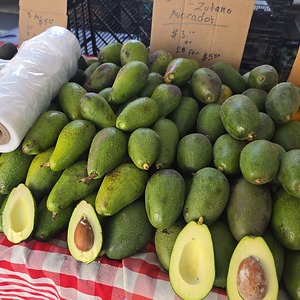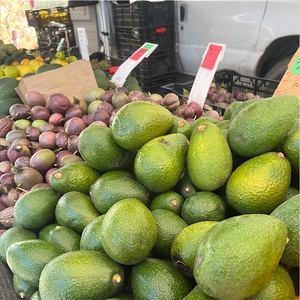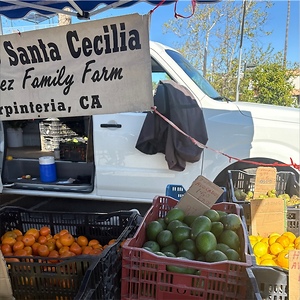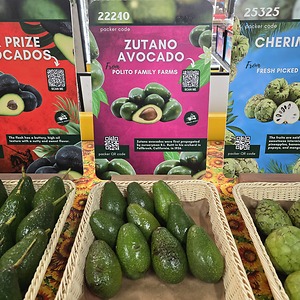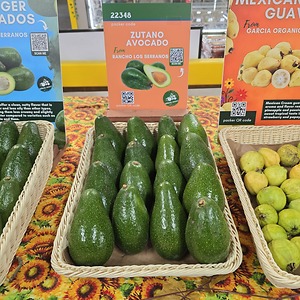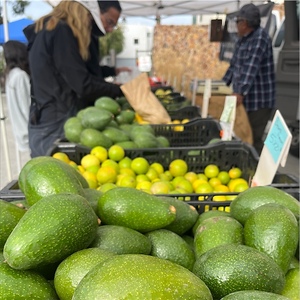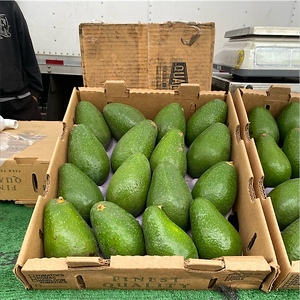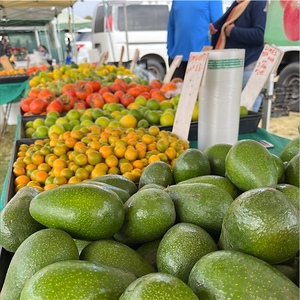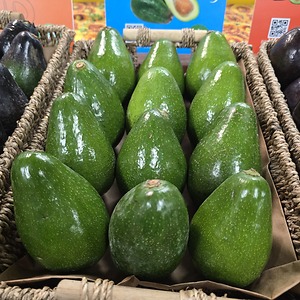


Zutano Avocados
Estimated Inventory, 25 lbs : 0
Description/Taste
Zutano avocados are a small to medium-sized varietal, averaging 10 to 15 centimeters in length, and have an elongated, pyriform to obovate shape with a broad, curved base tapering to a slender neck. The variety is typically harvested between 200 to 450 grams in weight and showcases thin, glossy, and green skin with a pebbled feel. The skin remains green, even when ripe, and some brown spots may appear on the bottom of the fruit if left too long on the tree. The skin also showcases yellow spots on the surface and is leathery, elastic, and easy-to-peel. Underneath the skin, the flesh is low in oil and high in water, creating a firmer, moist consistency. The flesh’s texture will largely depend on cultivation and its growing environment. Zutano avocados range from being slightly watery to creamy, silky, and lightly fibrous. The pale yellow-green flesh also encases a large, pointed, dark brown seed that is easily removed from the flesh without leaving husk pieces. Zutano avocados are edible once ripe and have a mild, refreshing, light, and neutral flavoring. The variety does not bear the characteristic oily, nutty, or roasted nuances of other commercial cultivars, but some consumers note a light, lemon-like nuance to the flesh.
Seasons/Availability
Zutano avocados are available in the mid-fall through late winter.
Current Facts
Zutano avocados, botanically classified as Persea americana, are a variety belonging to the Lauraceae family. The 20th century cultivar was commercially released in Southern California and is a Mexican-type avocado favored for its hardiness and easy-to-grow nature. Zutano avocados are one of the most cold-tolerant varieties and consistently produce high yields each season. The variety is also tolerant to high temperatures and resistant to sunburn, making them an adaptable cultivar for both home gardens and commercial orchards. Historically, Zutano avocados were a widespread cultivar in California, but as other commercial avocados attracted consumer attention, such as the dominant Hass, Zutano avocados slowly faded from favor in retail markets. The variety was at one point considered more costly to grow than the price it could obtain in markets. Zutano avocados have since suffered from varying reputations and their evergreen skin makes determining their degree of ripeness more challenging than other retail varieties. Despite these hurdles, Zutano avocados are still commercially grown on a small-scale in California, but the variety is prized more for its cultivation qualities than its fruit. Zutano avocados are a type B cultivar, meaning their female flowers open in the afternoon, and the trees are large and spreading, reaching 10 to 12 meters in height. Some growers still choose to harvest the fruits by hand and sell the avocados for their lighter, refreshing taste. Zutano avocados are primarily considered a farmer’s market cultivar, and the fruits have a mild flavor utilized in fresh culinary preparations.
Nutritional Value
Zutano avocados have not been extensively studied for their nutritional properties. Avocados, in general, are a source of fiber to regulate the digestive tract, folate to assist in everyday brain operations, magnesium to control nerve functions, potassium to balance fluid levels within the body and replenish electrolytes, and other nutrients like copper and niacin. Avocados also provide vitamins C, E, and K to strengthen the immune system, guard the cells against the damage caused by free radicals, and to aid in blood coagulation for faster wound healing.
Applications
Zutano avocados have a very mild, light, and refreshing taste suited for fresh preparations. The variety has a distinct taste from other common commercial cultivars like Hass as it is lower in oil, making it lighter and less oily and nutty. Zutano avocados are valued for their more neutral flavor and are incorporated into fresh dishes to add texture. The variety can be utilized in guacamole recipes where the taste of other ingredients is the desired focal point. They can also be sliced and sprinkled with salt, lemon, or lime juice as a topping over tacos, layered in sandwiches, or added to grain bowls. Try halving Zutano avocados and filling the cavity with various meats and spreads like tuna, crab, or chicken salads as a healthy meal. Zutano avocados can also be pureed with lemon juice, salt, desired seasonings, and a dab of olive oil to make creamy salad dressing. The variety can be incorporated into smoothies as a thickening agent or used as a binder in baked goods such as brownies. Zutano avocados can be used in any fresh recipe calling for a lighter, less rich avocado. The variety is also often served with seafood as a healthy accompaniment. Zutano avocados are not commonly added to cooked preparations due to their higher water content. The variety pairs well with fresh herbs such as cilantro, parsley, dill, and basil, spices including cumin, paprika, sumac, and turmeric, and meats such as beef, pork, and poultry. Avocados do not ripen on the tree and will be found in markets at varying degrees of ripeness. Leave the fruits at room temperature until desired ripeness. Once mature, store avocados in the refrigerator or immediately consume for the best quality and flavor. Opened avocados discolor when exposed to air. It is recommended to sprinkle the exposed flesh with lemon juice to slow browning, wrap in plastic, and store in the fridge for 1 to 2 days.
Ethnic/Cultural Info
Zutano avocado trees are primarily known for their role as a pollinator and rootstock in commercial production rather than a fruit-bearing cultivar. In the mid to late 20th century, California avocado growers noticed that Hass avocado trees that were planted near Zutano trees showed increased yields of larger fruits. Growers began planting Zutano avocado trees around the perimeter of Hass avocado orchards for increased pollination as the Zutano trees produced large amounts of flowers and had a complimentary pollination schedule and fruiting season to Hass. Zutano avocado trees are also used to pollinate other type A avocado types, including Jan Boyce and Pinkerton. Beyond pollination, Zutano avocado trees are used as rootstock to graft other avocado varieties for commercial sale. Zutano avocado rootstock is hardy and vigorous, allowing more popular avocado varieties to flourish, and the variety is ideal for the California soil and climate, making it a choice rootstock. Zutano seeds are also used by commercial growers as nurse seeds in breeding. The seeds germinate quickly and produce thick stems for tip-grafting.
Geography/History
Zutano avocados were first propagated by nurseryman R.L. Ruitt in his orchard in Fallbrook, California, in 1926. Much of the variety’s history is unknown beyond its site of origin, but Zutano avocados are one of the older cultivars commercially grown throughout California. Zutano avocados were initially popular after their release in the mid to late 20th century for their hardiness and favorable cultivation characteristics. Over time, the fruits faded from commercial sales in favor of richer varieties with a higher oil content, mainly Hass avocados. Today, Zutano avocados are still commercially grown but are not widely cultivated for their fruits. The variety is primarily used for breeding and increased pollination in Hass orchards. Zutano avocados are also used as a secondary variety when there is a gap in retail markets. When in season, small batches of Zutano avocados are offered through farmer’s markets, orchard fruit stalls, and select wholesalers in California. The variety is cultivated throughout Southern California and the San Joaquin Valley and is also planted in home gardens.
Recipe Ideas
Recipes that include Zutano Avocados. One
| Patch.Com |
|
Winter Fruit Salad with Zutano Avocado |
| Patch.Com |
|
Winter Fruit Salad with Zutano Avocado |
Podcast



